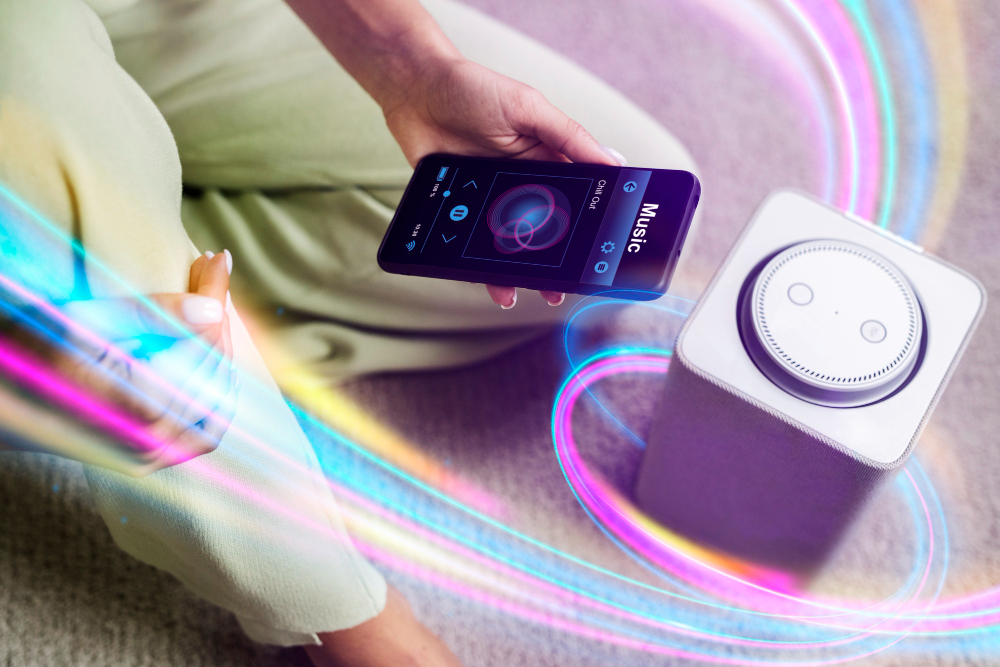
AI Voice Assistants
At Akross IT, we design and deploy smart AI Voice Assistants that enable natural, hands-free communication between users and technology. Built on advanced speech recognition, natural language understanding, and machine learning, our voice solutions go beyond simple commands—they listen, learn, and respond in real time, driving accessibility, automation, and user engagement like never before.


The Future is Voice-First
Voice is becoming the most intuitive interface for users across industries. Whether it’s streamlining customer service, powering smart devices, or enhancing in-app navigation, AI Voice Assistants are redefining how businesses connect with their users. At Akross IT, we build intelligent voice interfaces that seamlessly integrate with your systems, understand context, and deliver fast, accurate responses—all while improving over time through continuous learning.
Key Features of Our Voice Assistants
🎤 Advanced Speech Recognition
Accurately transcribe and process natural speech input across multiple languages and accents.
🧠 Context-Aware NLU
Understand user intent, tone, and conversation flow to provide relevant and personalized responses.
🔄 Real-Time Processing
Respond instantly to voice commands or questions, ensuring smooth, latency-free interactions.
🔌 Seamless Integrations
Connect to your backend systems, CRMs, APIs, and third-party platforms for powerful voice-driven automation.
📈 Analytics & Feedback Loops
Track usage patterns, identify drop-off points, and continually enhance user experience with real-time data insights.
Our Voice Assistant Development Process
AI Voice Assistant development involves designing natural, intuitive voice interactions that align with your brand. The process starts with use case mapping and voice persona creation, followed by dialogue design and advanced speech recognition integration. We connect the assistant to backend systems for real-time automation and ensure seamless multi-platform deployment. Continuous monitoring and optimization keep the assistant smart, responsive, and user-focused.
Use Case Discovery & Voice Persona Design
We begin by understanding your business objectives and identifying where voice interaction can create the greatest value—whether it's in automating repetitive tasks, enhancing customer support, or making systems more accessible.
Alongside this, we craft a distinct voice persona that aligns with your brand's identity. This includes tone of voice, style of language, vocabulary preferences, and emotional resonance to ensure the assistant communicates with personality and professionalism.
Dialogue Flow & UX Mapping
Next, we design user-centric conversational flows that feel natural, purposeful, and contextually aware. Our UX experts plan every step of the dialogue journey, accounting for various user paths including success flows, clarifications, error handling, and escalation scenarios.
This step ensures the assistant guides users effortlessly through interactions, creating a seamless and satisfying voice experience that adapts to user behavior.
Speech Recognition & NLP Integration
With the conversation framework in place, we integrate advanced speech-to-text (STT) and natural language processing (NLP) technologies. Depending on your needs, we implement top-tier engines like Google STT, Amazon Lex, or OpenAI Whisper to deliver real-time, high-accuracy voice transcription.
We also fine-tune intent recognition and language models to handle diverse accents, natural pauses, and nuanced queries—ensuring the assistant can truly understand and respond to human speech effectively.
Backend & System Integrations
To turn your voice assistant into a smart automation engine, we connect it with your internal systems—CRMs, databases, scheduling tools, APIs, and third-party platforms. This integration enables the assistant to perform dynamic, data-driven actions like booking appointments, checking statuses, updating records, or fetching personalized responses—all through simple voice commands.
We ensure data flow is secure, efficient, and fully synchronized with your workflows.
Testing & Tuning
Before going live, we conduct exhaustive testing to ensure the assistant performs flawlessly across devices, environments, and user inputs. This includes voice interaction testing with multiple accents, background noise levels, and device types. We monitor response times, accuracy rates, and interaction flow, making iterative refinements to improve understanding and responsiveness.
This tuning phase is critical to delivering a polished, reliable voice experience from day one.
Deployment Across Channels
Once testing is complete, we deploy your voice assistant to the platforms your audience uses most—be it websites, mobile apps, IVR systems, smart speakers, or embedded devices. Each channel is configured for optimal performance, ensuring smooth interaction regardless of the device or platform.
Our scalable architecture supports a high volume of concurrent users and delivers consistent uptime and responsiveness.
Monitoring & Continuous Improvement
Post-launch, we remain actively involved in monitoring your voice assistant's performance. Using real-time analytics, we track metrics such as intent match rates, user satisfaction, and engagement levels. Feedback is analyzed to identify areas for improvement, and updates are rolled out regularly to expand capabilities, refine conversations, and enhance the overall user experience.
The assistant continues to learn and evolve—growing smarter with every interaction.
Types of AI Voice Assistants We Build
Customer Service Voice Assistants
Handle incoming support calls, provide 24/7 assistance, resolve common issues, and route calls intelligently based on context.
Smart Home & IoT Voice Interfaces
Enable users to control devices, manage settings, and receive updates through voice—creating a truly connected experience.
In-App Voice Assistants
Enhance mobile or web apps with voice-enabled navigation, feature access, or form filling for hands-free convenience.
Voice-Enabled Virtual Receptionists
Automate front-desk or helpline interactions, greet callers, schedule appointments, and reduce wait times in real time.
Enterprise Productivity Bots
Integrate voice assistants with internal tools like calendars, task managers, and dashboards to boost team efficiency.




